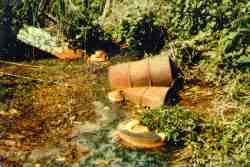
Technological

Technological disasters are human-caused disasters that negatively impact people and their property. The most well-known example of a technological disaster is a nuclear accident which can, of course, severely impact widespread populations.
But there are other technological disasters that can affect the farm community. For example, a year-long study released in March 2000 indicated that drinking water supplies for some 200,000 New Jersey residents had become tainted with radium. Farmers in those areas not only had to consider the safety of their own drinking water but also the safety of all the water used on their farms.
Other technological disasters that can affect farms include:
![]() Tainted rivers or water supplies.
Tainted rivers or water supplies.
If chemical spill or other harmful runoff flows into a river or creek that is close to a pasture, livestock or crops can be poisoned. Any contaminated water that harms people can also harm a farmer's crops or animals. In Maryland, for example, an infestation of pfisteria in recent years has hurt fish harvests, infected people who harvest fish or crops near the water, and sickened animals who come into contact with infected fish.
![]() Buried waste or former landfills.
Buried waste or former landfills.
If chemical waste is buried underneath a farm, harmful effects can take years to appear. Farmers may notice themselves or their families getting sick. Their livestock may become ill and crops may wither. Currently the U.S. government and many state governments are researching how to safely reclaim former industrial or dumping sites in rural areas, also called "brownfields."
![]() Insecticide poisoning.
Insecticide poisoning.
Insecticide that hasn't been adequately tested but is applied to crops can harm farmers or people working on farms. Long-term effects can occur years after the use of the insecticide.
![]() Oil spills.
Oil spills.
Oil spills, whether they remain out to sea or wash ashore, can wipe out entire fish harvests and coastal crops. In addition, people who depend on fishing for their food or for subsistence farming are often gravely affected.
![]() Vandalism and dumping.
Vandalism and dumping.
When people dump old appliances or tires in the middle of a field, a farmer's equipment can sustain heavy damage and cost thousands of dollars to repair or replace.
![]() Global warming.
Global warming.
Many scientists believe that a gradual rise in the earth's temperature, caused in part by pollutants, is taking place and that it will lead to more severe and prolonged droughts. In turn, researchers are trying to find crops that are more drought-proof. And farmers continue to try to prepare themselves for future years of potential dry weather.
![]() Pests and infestations.
Pests and infestations.
Infestations by bacteria and by insects can cause widespread crop destruction. For example, in March 2000, the bacteria canker wiped out millions of dollars worth of citrus crops in south Florida. And sometimes insects may get accidentally imported into the United States. For example, the Asian Longhorned Beetle, which has no known predators, quickly destroys hardwood trees.

Get Help | About | Links | Email Lists | Search | Disaster News Network | Email
Farm Disaster Resource Net is maintained by Disaster News Network. Copyright © 1998-2007 Village Life Company. All Rights Reserved